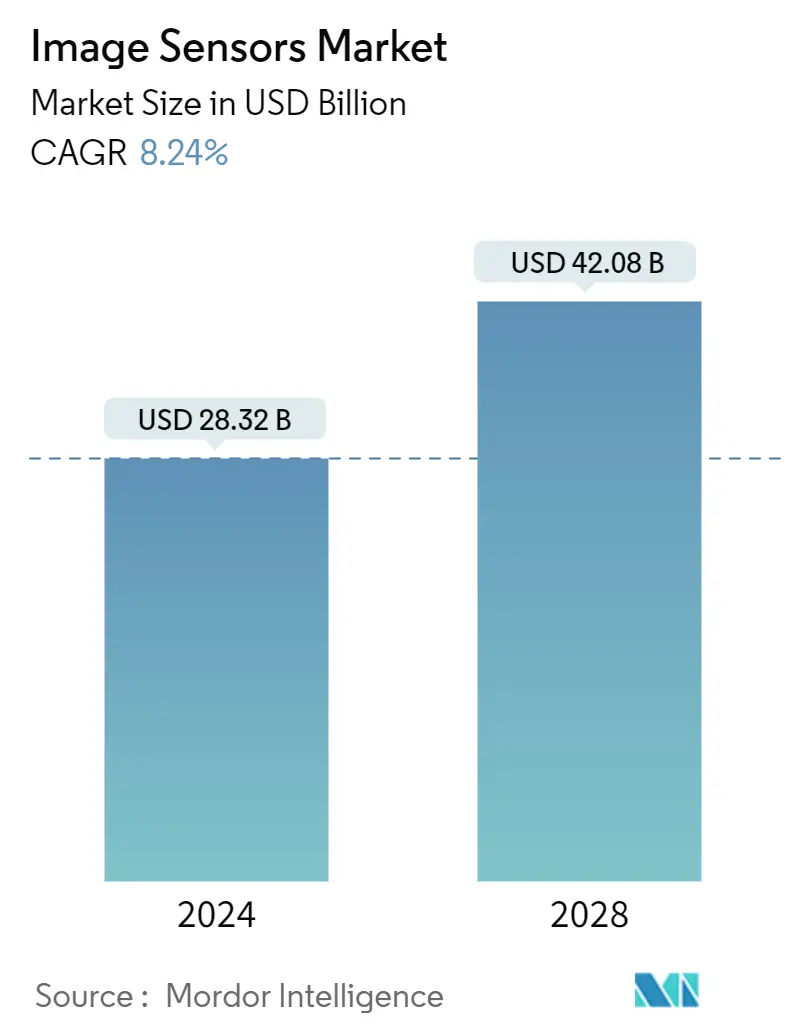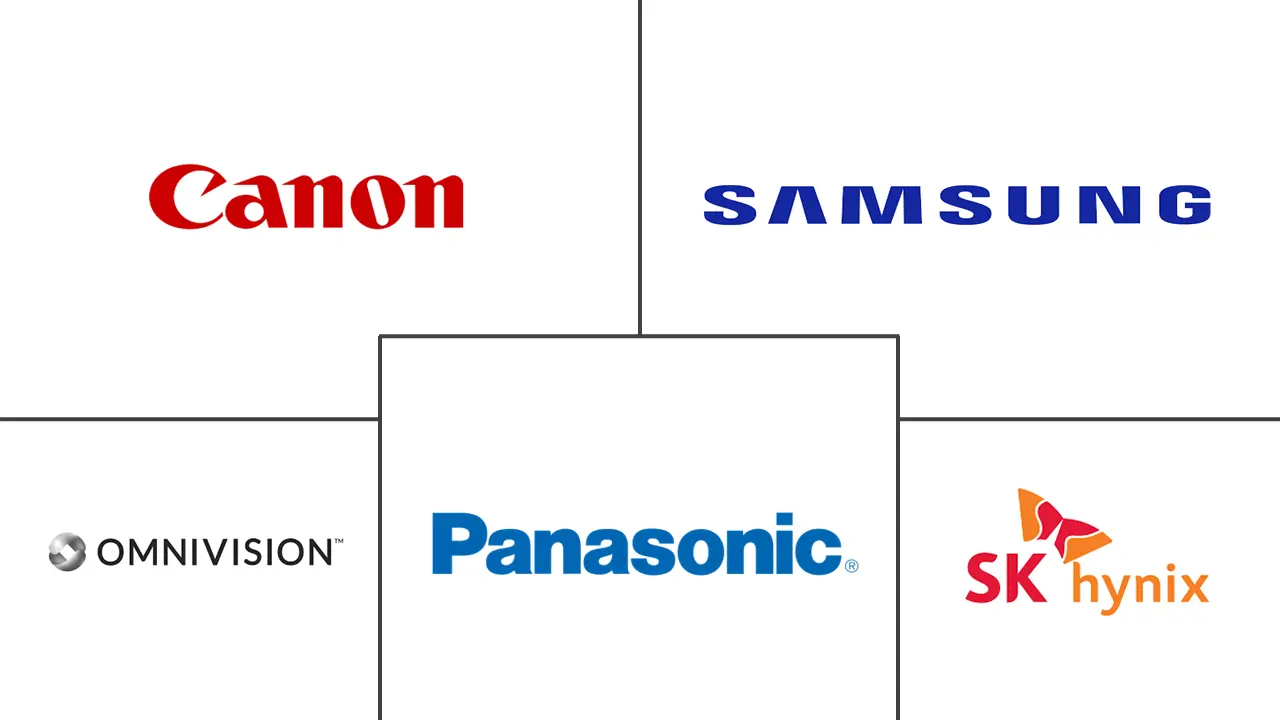Market Size of Image Sensors Industry

| Study Period | 2019-2029 |
| Market Size (2024) | USD 28.32 Billion |
| Market Size (2029) | USD 42.08 Billion |
| CAGR (2024 - 2028) | 8.24 % |
| Fastest Growing Market | Asia Pacific |
| Largest Market | Asia Pacific |
| Market Concentration | Low |
Major Players
*Disclaimer: Major Players sorted in no particular order |
Image Sensors Market Analysis
The Image Sensors Market size is estimated at USD 28.32 billion in 2024, and is expected to reach USD 42.08 billion by 2029, growing at a CAGR of 8.24% during the forecast period (2024-2029).
The image sensors are used primarily in many imaging devices and digital cameras to enhance the image's quality of picturization and storage with its applications in industrial, media, medical, and consumer applications. Hence, the wide application area of image sensors drives their demand across various end-user verticals.
- The integration of video surveillance in the automotive and transportation industry is one of the significant trends observed across various regions. For instance, to enhance security for the Canadian Public Transportation System, with the country having millions of daily traffic, the government has deployed a unified surveillance System with integrated cameras. This is further expected to surge the demand for image sensors.
- In recent years, the smartphone has become the primary camera device in consumer electronics, dominating still cameras and DSLRs. Due to the growing demand for smartphones, the image sensors market is expected to record a high growth rate during the forecast period. Manufacturers worldwide have been striving to improve major parameters, such as resolution, performance, and pixel size, which are also driving innovations in the image sensors market. For example, Samsung has recently introduced its latest 200-megapixel (MP) image sensor for its flagship series of smartphones. Samsung's new ISOCELL HP2 image sensors feature improved pixel technology and full-well capacity for high-quality mobile images.
- The growing popularity of innovative consumer electronic devices, such as smartwatches, AR/VR headsets, etc., is driving the demand for image sensors. For instance, according to the Consumer Technology Association (CTA), the sales revenue of wearables in the United States is anticipated to reach USD 13.8 million in 2023.
- Also, the companies are recognized for their product innovation in the studied market, which is encouraging them to launch new image sensors with innovative features. For instance, in January 2023, ams OSRAM extended its Mira family of high-sensitivity, global shutter CMOS image sensors with the introduction of the 2.3mm x 2.8mm, 0.5Mpixel Mira050, a highly sensitive sensor that enables engineering designers to save power and space in wearable and mobile devices. Its sensitivity to both visible and near-infrared (NIR) light makes Mira050 suitable for applications such as eye tracking, contextual awareness in AR/VR/MR headsets, gesture tracking, 3D depth sensing for face recognition in smart door locks, and object detection in robots.
- However, with the miniaturization trend prevailing in the sensor and electronic device industry, the design and manufacturing complexity in the studied market continues to grow significantly, which continues to challenge the studied market's growth. Additionally, the high cost of quality image sensors also continues to remain a major pain point for users, especially in the lower and mid-range device/equipment segment.
- The impact of macroeconomic factors is also a challenging factor for the studied market's growth as the economic condition of consumers largely impacts their buying capability of consumer electronic products. For instance, owing to the recent economic slowdown, the consumer electronics industry in the United States has also been witnessing a slowdown, with consumer technology retail revenue taking a dip to reach USD 485 billion in 2023, compared to USD 505 billion in 2022.
Image Sensors Industry Segmentation
The image sensor is a device that detects and conveys information used to make an image by converting the variable attenuation of the light waves into the signals that give the information.
The image sensors market is segmented by type (CMOS, CCD), end-user industry (consumer electronics, healthcare, industrial, security and surveillance, automotive & transportation, aerospace & defense), and geography (North America (United States, Canada), Europe (United Kingdom, Germany, France, Rest of Europe), Asia Pacific (China, India, Japan, Rest of Asia Pacific), Rest of the World). The market sizes and forecasts are provided in terms of value in (USD) for all the above segments.
| By Type | |
| CMOS | |
| CCD |
| By End-user Industry | |
| Consumer Electronics | |
| Healthcare | |
| Industrial | |
| Security and Surveillance | |
| Automotive and Transportation | |
| Aerospace and Defense | |
| Other End-user Industries |
| By Geography | ||||||
| ||||||
| ||||||
| ||||||
| Rest of the World |
Image Sensors Market Size Summary
The image sensors market is poised for significant growth, driven by their extensive application across various sectors such as industrial, media, medical, and consumer electronics. These sensors are integral to enhancing image quality in devices like digital cameras and smartphones, which have become the primary camera devices in consumer electronics. The market is witnessing a surge in demand due to the increasing integration of video surveillance in the automotive and transportation industries, as well as the growing popularity of innovative consumer electronic devices like smartwatches and AR/VR headsets. Manufacturers are focusing on improving key parameters such as resolution, performance, and pixel size, leading to innovations like Samsung's advanced image sensors. However, challenges such as design complexity, high costs, and macroeconomic factors like economic slowdowns pose obstacles to market growth.
The Asia Pacific region is experiencing substantial growth in the image sensors market, fueled by the booming automotive and consumer electronics industries. Countries like China and India are at the forefront, with China emerging as a significant player in image sensor production and India witnessing increased demand due to rising digital technology penetration and smart city initiatives. The market is characterized by intense competition, with numerous local and global players vying for market share. Key players include Canon Inc., Samsung Electronics Co. Ltd., and Omnivision Technologies Inc., among others. Recent technological advancements, such as Panasonic's Organic Photoconductive Film CMOS Image Sensor Technology and Teledyne e2v's Hydra3D+ sensor, highlight the ongoing innovation in the sector. Despite the challenges, the market presents significant investment opportunities, attracting new entrants and fostering a dynamic competitive landscape.
Image Sensors Market Size - Table of Contents
-
1. MARKET INSIGHTS
-
1.1 Market Overview
-
1.2 Industry Value Chain Analysis
-
1.3 Industry Attractiveness - Porter's Five Forces Analysis
-
1.3.1 Bargaining Power of Suppliers
-
1.3.2 Bargaining Power of Consumers
-
1.3.3 Threat of New Entrants
-
1.3.4 Threat of Substitutes
-
1.3.5 Intensity of Competitive Rivalry
-
-
1.4 Assessment on the Impact of COVID-19 on the market
-
-
2. MARKET SEGMENTATION
-
2.1 By Type
-
2.1.1 CMOS
-
2.1.2 CCD
-
-
2.2 By End-user Industry
-
2.2.1 Consumer Electronics
-
2.2.2 Healthcare
-
2.2.3 Industrial
-
2.2.4 Security and Surveillance
-
2.2.5 Automotive and Transportation
-
2.2.6 Aerospace and Defense
-
2.2.7 Other End-user Industries
-
-
2.3 By Geography
-
2.3.1 North America
-
2.3.1.1 United States
-
2.3.1.2 Canada
-
-
2.3.2 Europe
-
2.3.2.1 United Kingdom
-
2.3.2.2 Germany
-
2.3.2.3 France
-
2.3.2.4 Rest of Europe
-
-
2.3.3 Asia-Pacific
-
2.3.3.1 China
-
2.3.3.2 India
-
2.3.3.3 Japan
-
2.3.3.4 Rest of Asia-Pacific
-
-
2.3.4 Rest of the World
-
-
Image Sensors Market Size FAQs
How big is the Image Sensors Market?
The Image Sensors Market size is expected to reach USD 28.32 billion in 2024 and grow at a CAGR of 8.24% to reach USD 42.08 billion by 2029.
What is the current Image Sensors Market size?
In 2024, the Image Sensors Market size is expected to reach USD 28.32 billion.

